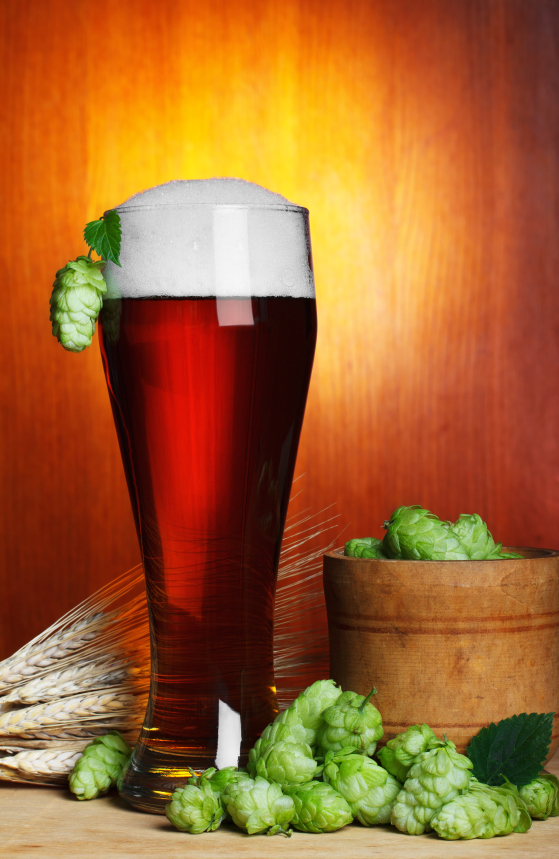This week I take a look at some of the new hop products and forms of hops available to professional and home brewers. We’re fortunate to live in an era of hop forward beers, and brewers have a wide variety of products available to create great beers.
Dried Hop Forms
The vast majority of hops we use as brewers are in a dried hop form. These include whole hops, hop pellets and hop plugs. These hops are harvested, dried to a low moisture content level, and packaged. Pellet hops are chopped and compressed into small pellets before packaging. Plug hops are whole hops that are not ground, but pressed into discs approximately 1/2-3/4 inch or a bit over 1 cm in diameter, while whole hops are kept in a whole cone form.
The vast majority of hops sold today are in pellet form. Whole hops are fairly rare, and plug hops even rarer these days. Pellet hops generally store best because they have less surface area than whole leaf hops, and have slightly higher hop utilization. Plug hops also have slightly better storage characteristics than leaf, and are not chopped up like pellet hops. Leaf hops have the shortest shelf life, but can be great if you get them fresh.
The enemies of hops are light, heat and oxygen, so modern hop packaging is typically done in a vacuum packed foil pouch to prevent all three. Also hops are now stored at near freezing, typically in a freezer, to minimize heat which can age your hops prematurely.
Wet, Fresh and Frozen Whole Hops
The term “wet hops” denotes fresh hops from the bine that have not been dried or processed. These have an extremely short shelf life, and typically need to be used within 1-3 days of their harvest. I’ve written a full article on how to use these here, but typically you need to use 5-6x more hops by weight as these hops have a much higher water content than dried hops. Wet hops typically give you a much greener, vegetal finish than dried hops.
Some hop growers have also started flash freezing fresh whole hops and vacuum packing them so you can store them frozen like pellet hops. While not inexpensive, this can be a good option if you want to try brewing with wet hops and don’t have access to your own hop plants.
CO2 Hop Extract
CO2 Hop extract is the most common form of hop extract. It is widely used for bittering at the commercial level since the extract can be stored for years. The method distills the bittering compounds down to a thick syrup which is typically sold in cans at the professional level or small syringes at the homebrew level. I have an article on using hop extracts here.
CO2 extract is really only suitable for bittering additions, as it has little aroma compound, and it must be boiled to isomerize the alpha acids. Because it is concentrated it typically contains about 60-70% alpha acids. Effectively you can treat it like other bittering hop additions, but at a 60+% alpha level by weight instead of the 4-15% level you might get from pellet hops. BeerSmith lets you specify CO2 extract and enter the amount in milliliters which is typically how dosing is measured, and you can enter the alpha acid from the label on the can which again is typically in the 60% or higher range.
Isomerized Hop Extract
While more rare and expensive than CO2 extract, isomerized extract is available both at the home and commercial level. Isomerized hop extracts have the significant advantage in that the alpha acids (bittering compounds) have already been isomerized before being concentrated. This means you can add the extract to a finished beer to increase the bitterness of the beer. So if you have a finished beer where the hop level is simply too low, you can directly add isomerized hop extract “to taste” until you achieve the bitterness level you want. Isomerized extract is used as a bittering addition as it contains low levels of aroma oils.
Lupulin Powder and Cryo Hops
Lupulin powder is a dry powder extracted and concentrated from the lupulin gland of the hop cone using a proprietary process. Unlike CO2 extract, lupulin powder does a good job of preserving the aroma oils in the hops, and therefore lupulin powder is best used in dry hopping.
Since it is concentrated, you can use fewer ounces than you might when using regular dry hops. The proprietary Cryo hops is another version of lupulin powder from YCH hops and is used in the same way.
Aroma Oil Extracts
Perhaps the newest hop product for home and professional brewers are a variety of hop aroma oil extracts. These are sold at the homebrew level as drops, and can be added directly to a finished beer. The most common ones I’ve seen are sold as the aroma extract from a particular hop variety such as citra. Adding a few drops to a pint of beer will result in an explosive aroma.
At the professional level you can also purchase individual hop oils such as myrcene, geraniol, and linalool to adjust specific aroma components of a finished beer. Depending on your goal you can add these either at the tail end of fermentation to enable biotransformations or add them to a finished beer to increase aromatics. Choosing the correct amount to add and best mix of oils can be a challenge, though you can add them to the finished beer in small increments until you achieve the aroma levels you want to achieve.
I hope you enjoy this week’s summary of the latest hop products from the BeerSmith Home Brewing Blog. Please subscribe for regular weekly delivery, and don’t hesitate to leave a comment or send this article to a friend.
